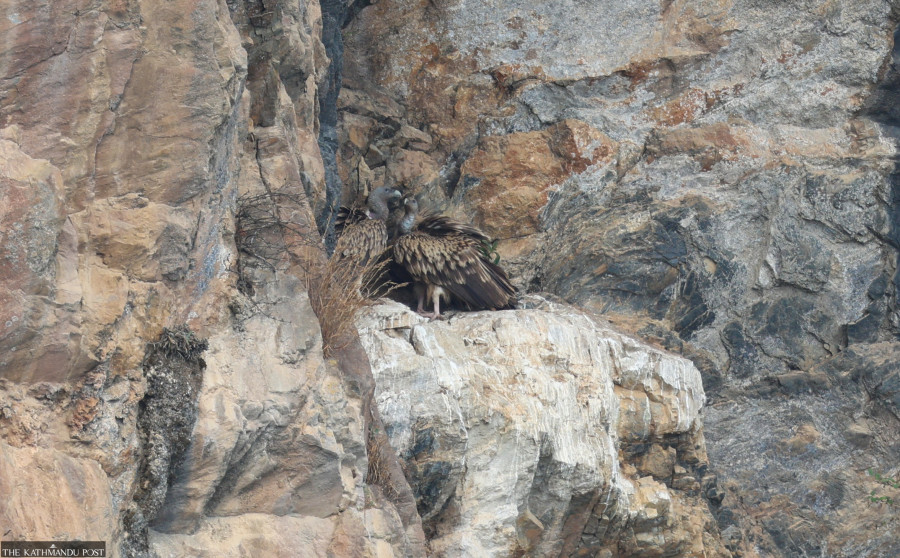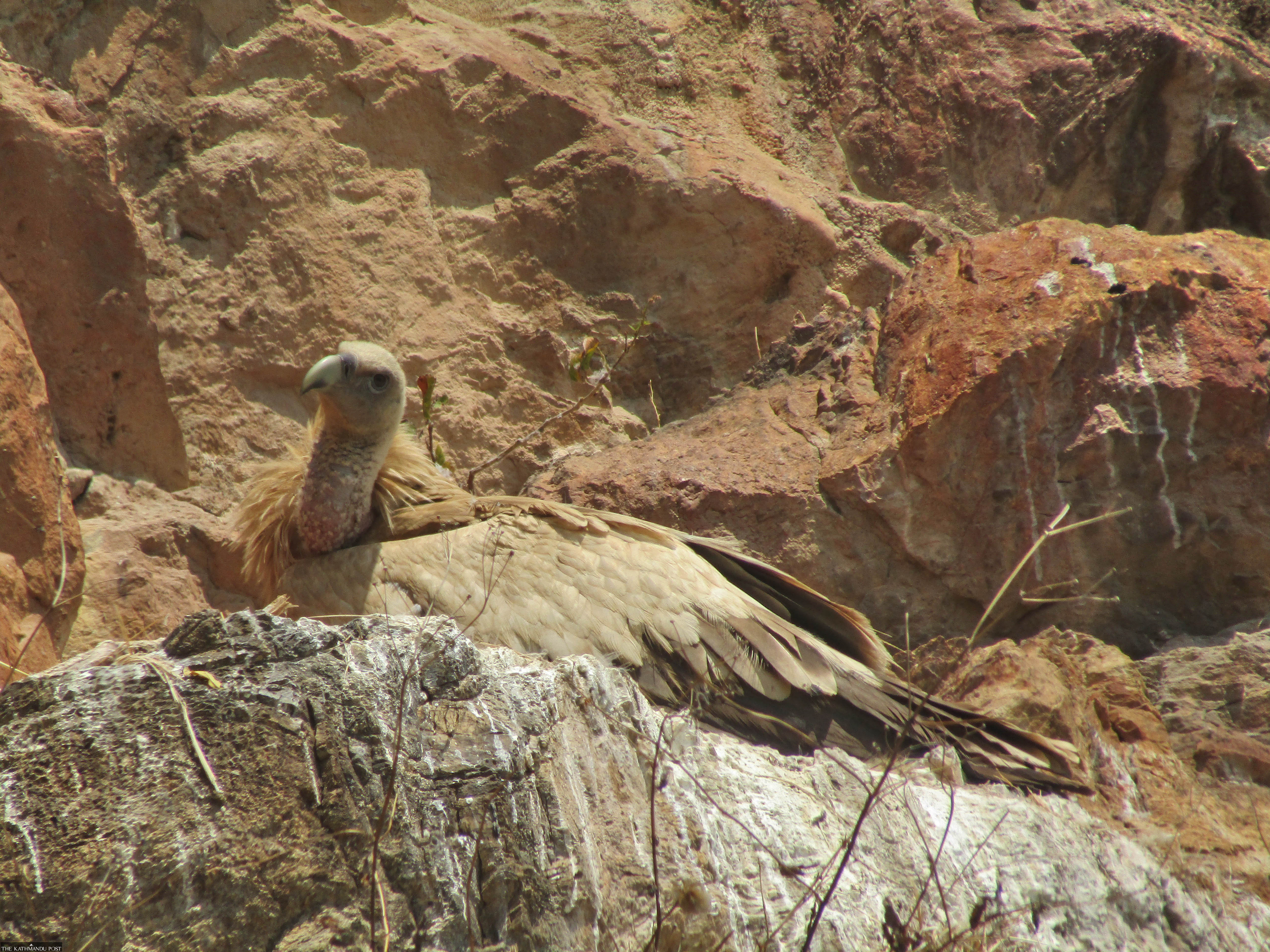Lumbini Province
Gherabhir cliff in Arghakhanchi is buzzing with nesting vultures
30 pairs of Himalayan griffons, and one pair each of bearded vultures and Egyptian vultures are currently raising their young.
Manoj Paudel
Gherabhir, a rocky cliff in ward 6 of Malarani Rural Municipality in Arghakhanchi district, has lately become a safe haven for vulture conservation in the country.
“A total of 32 pairs of vultures—30 pairs of Himalayan griffons, one pair each of bearded vultures and Egyptian vultures—are currently raising their fledglings in the Gherabhir area. This is great news for vulture conservation in the country,” said Dilip Chand Thakuri, project officer at the non-profit Bird Conservation Nepal.
According to Thakuri, as many as 37 pairs of vultures were found building their nests in the Gherabhir area during this year’s monitoring. “Among them 32 pairs successfully reproduced their offspring while five pairs laid eggs, but could not hatch them,” he added.
Parent vultures of Himalayan griffons, bearded vultures are to be seen in the Gherabhir and Lek areas teaching their fledglings to fly. The fledglings, according to ornithologists, flap their wings in the nests. Later they are dragged out of the nests by their parents to help them take flight. “But the Egyptian vultures will likely teach their chicks to fly about a month later,” said Thakuri.
The parent vultures start building their nests between mid-September and mid-December on the cliffs. The mother vultures then lay eggs around January and brood in the nest for about two months. The eggs hatch around February-March, and the vulture hatchlings are ready to fly after three months.
“The fledglings are now learning to fly. They will have completely learned by the end of June,” said Krishna Bhusal, an ornithologist who did his postgraduate degree in vulture conservation. According to him, the breeding process of the Egyptian vulture is around one to two months later than the other species.
Of the nine species of vultures recorded in Nepal, four species—white-rumped vulture, slender-billed vulture, red-headed vulture and Indian vulture—are listed as critically endangered. The Egyptian vulture is listed as endangered, while the bearded vulture, cinereous vulture and Himalayan griffon, have been classified as near-threatened.
The Himalayan griffon makes a nest of hay and lines it with its own feathers, while the Egyptian vulture and bearded vulture make a nest of twigs and cloth scraps.
The parent vultures only feed raw meat to their nestlings. After finding meat, they swallow it, and upon returning to the nest, regurgitate it into the nestling's mouth.
“Both parents of the baby vultures take turns bringing food, and sometimes they travel around 3 to 4 kilometres to find meat. Many nests are built in a small area of the Gherabhir cliff. This area can be developed as an important site for those who want to watch vulture breeding,” said Bhusal.
Bhushal, who has been working on vulture conservation for a decade and a half, further added that Gharebhir could be the best place in the world where three species of vultures nest and raise their offspring in one location.
Due to its richness in biodiversity, the Bird Conservation Nepal and Bird Life International have also declared the Argha area of Arghakhanchi district an important bird conservation area.
A pair of vultures stay together for life, they do everything together, from nest construction to hatching and rearing their young.
It is estimated that there are 10,000 Himalayan griffons in Nepal, less than 1,000 Egyptian vultures, and only 500 bearded vultures.

The vultures also have religious, cultural, and environmental significance. The vulture plays an important role in keeping the polluted and smelly environment clean, sanitised, and free from disease.
According to experts, the vultures also help in controlling the spread of epidemics like cholera, rabies, plague, and anthrax by keeping the environment clean. It is crucial to protect vultures, as they play an important role in ecological harmony and making the food chain balanced and dynamic.
A vulture eats around 1 kg of carrion in three days and around 120 kg in a year.
The Himalayan, Egyptian, and bearded species of vultures make their nests on cliffs, whereas the species of white-rumped, slender-billed, and red-headed vultures build their nests in trees. Among the nine species found in Nepal, only these six build their nests and lay eggs in Nepal, whereas the other three do not.
“A monitoring team is deployed from the moment the endangered vultures start building their nest for regular monitoring and conservation,” said Ishan Thapa, an executive officer at the Bird Conservation Nepal. “Finding such a location is very difficult for the birds, and to watch three species in one area is truly mesmerising. Protecting these sites is very important,” Thapa added.
Hari Prasad Khanal of Malarani said that he was unaware of the environmental importance of vultures, but upon learning about it, he voluntarily joined the efforts to protect them.
“Several other local residents, like me, also guard the vulture nests to protect them from wild animals and other threats. The locals used to dislike the vultures in the past, but now their attitudes have changed,” said Khanal.
The locals are optimistic that these conservation efforts will help develop the area as a birding destination in the country.




 8.12°C Kathmandu
8.12°C Kathmandu














